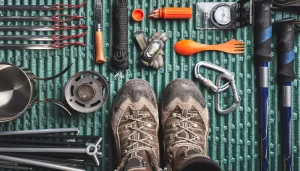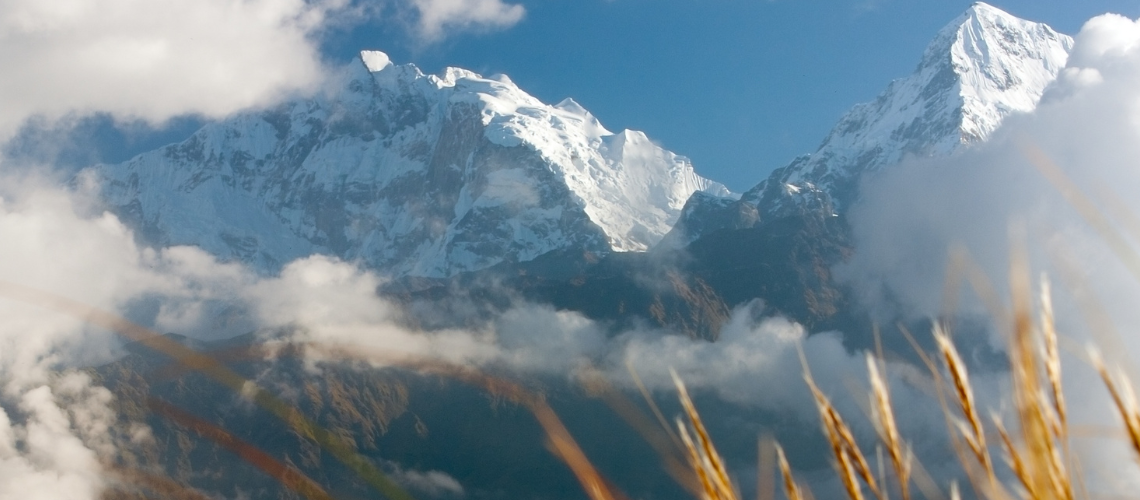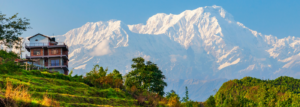You are set to go trekking to Nepal. But what about your trekking gear? You have to keep many things on your checklist before traveling to Nepal.
Trekking in Nepal means facing rough trails and unpredictable weather.
So you are set to go trekking in Nepal. But what about your trekking gear? There are tons of things you have to keep on your checklist before your trekking to Nepal,
Trekking in Nepal means facing rough trails and unpredictable weather. The right gear helps you stay safe during the journey and allows you to enjoy the trip.
However, there are things that you can not take with you while traveling to Nepal. So, stay with us to know about everything that will be your trekking buddy.
What are the essentials to pack for trekking in Nepal?
The trekking trails in Nepal for Everest base camp, Annapurna base camp, and many more are rough. These trekking gears help us tackle these rugged trails and keep us warm in the cold weather.
Let us learn about these essential trek gear while traveling to Nepal.
Clothing
- Down Jacket: Consider renting in Kathmandu if you don’t own one.
- Thermal Baselayer Set: Pack at least two sets for comfort and warmth.
- Fleece Pullover or Hoodie: Essential for layering and warmth.
- Lightweight Thermal Tops: Provides additional warmth without bulk.
- Waterproof Jacket and Pants: Protects against rain, snow, and wind.
- Hiking Shorts and T-shirts: Ideal for lower altitudes and sunny days.
- Hiking Pants: Opt for lightweight, quick-drying options.
- Gloves and Hats: Bring both lightweight and heavyweight options for varying conditions.
- Sports Bra and Underwear: Ensure comfort and support during the trek.
- Woolen Hat and Sunhat: Protects against cold and sun exposure.
- Microfleece Buff: Versatile accessory for warmth and protection.
Footwear
- Hiking Boots: Choose waterproof boots with ankle support.
- Sandals or Running Shoes: For use in teahouses and around camp.
- Hiking Socks: Pack enough pairs for comfort and moisture-wicking.
- Inner Socks: Thin socks to provide additional support.
Gears and Equipment
- Duffle Bag: Waterproof and spacious if using a porter.
- Rucksack with Rain Cover: Comfortable for carrying personal belongings.
- Daypack with Rain Cover: Essential for day trips and carrying essentials.
- Trekking Poles: Optional but beneficial for knee and joint support.
- Sleeping Bag and Liner: Ensure warmth and comfort during nights.
- Additional Accessories: Water bottle, trash bags, phone charger, power bank, local SIM card, cash, map, compass/GPS, camera, binoculars, head torch, and sunglasses.
Personal Hygiene and First Aid
- Toiletries: Biodegradable soap, toothbrush, toothpaste, etc.
- Personal Medications: Carry necessary prescription medications.
- First Aid Kit: Include bandages, antiseptic cream, pain relievers, etc.
- Small Wash Towel: Lightweight and quick-drying for hygiene.
Documents
- Passport and Visa: Ensure validity and obtain the necessary visa for Nepal.
- Travel Insurance: Comprehensive coverage for trekking at high altitudes.
- Permits and Tickets: Obtain all required permits for your trekking route.

What are the other optional trek gear to pack?
There are some additional essential equipment for trekking in Nepal that you should carry just in case.
- Trekking Poles: Provide stability and support, particularly on steep and uneven terrain.
- Water Purification Methods: Besides water bottles, consider carrying water purification tablets, a portable water filter, or a UV sterilizer.
- Head Torch/Headlamp: Essential for navigating trails in low light conditions or during early morning starts and late evening arrivals at teahouses. Opt for a lightweight and durable headlamp with adjustable brightness settings.
- Trekking Towel: A compact and quick-drying towel is invaluable for maintaining personal hygiene during the trek.
- Portable Power Bank: Keep your electronic devices, including smartphones, cameras, and GPS devices, charged with a reliable portable power bank. Ensure it has sufficient capacity to last the duration of your trek.
- Emergency Shelter: Pack a lightweight emergency shelter, such as a bivvy sack or emergency tent, to protect in case of unexpected weather or emergencies.
- Multitool or Knife: A versatile multitool or pocket knife can come in handy for various tasks during the trek, from cutting rope to repairing gear.
- Repair Kit: Carry a small repair kit with essential items like duct tape, needles, thread, and patching materials.
- Snacks and Energy Food: Pack lightweight and nutritious snacks like energy bars, trail mix, and dried fruits to fuel your trekking adventures.
What can you not bring to Nepal during your trekking?
While there isn’t a comprehensive list of trekking gear explicitly prohibited in Nepal, there are some considerations to keep in mind regarding the gear you bring:
- Single-use Plastics: Nepal has taken measures to reduce single-use plastics due to environmental concerns. It’s best to avoid bringing single-use plastic items such as water bottles, bags, and straws.
- Non-biodegradable Materials: Similar to single-use plastics, non-biodegradable materials like styrofoam and certain plastics can harm the environment. Choose gear and packaging materials that are eco-friendly and biodegradable whenever possible.
- Items Harmful to the Environment or Local Culture: Certain items may be considered harmful to the environment or local culture. For example, hunting or fishing gear, pesticides, and culturally insensitive materials should be avoided.
- Drones: While not explicitly prohibited, the use of drones in Nepal is regulated. Obtain the necessary permits and follow local regulations if you plan to bring a drone for photography or videography purposes.
- Cultural Artifacts: It’s essential to respect Nepal’s cultural heritage by refraining from removing artifacts from their original context or purchasing items of historical or cultural significance unless obtained through legal and ethical means.
Additionally, consider the weight and bulk of your gear when packing for trekking in Nepal. Carrying excessive or unnecessary items can make your trek more challenging and contribute to environmental degradation if disposed of improperly.
Packing light and prioritizing essential items that align with your trekking itinerary and environmental conservation efforts is best.
Buying or renting trekking gear from Kathmandu
Kathmandu is the bustling capital of Nepal. It offers many options for purchasing or renting trekking gear.
From traditional markets to modern outdoor gear stores, trekkers can find everything they need for their Himalayan journey. Here’s a popular gear store in Kathmandu:
- Outdoor Adventure Gear Stores: Kathmandu has numerous outdoor adventure gear stores offering a wide range of trekking equipment, from high-quality clothing to camping gear and accessories. Stores like The North Face, Sherpa Adventure Gear, and Mountain Hardwear are renowned for their durable and reliable products.
- Thamel District: Thamel, the vibrant tourist hub of Kathmandu, is dotted with countless shops and vendors selling trekking gear.
- Rental Shops: For travelers looking to save money or minimize luggage, renting trekking gear is a practical option. Several rental shops in Kathmandu offer a range of short- or long-term-use equipment, including sleeping bags, trekking poles, and down jackets.
- Specialized Gear Stores: Apart from mainstream outdoor gear stores, Kathmandu also boasts specialized shops catering to specific trekking needs. These stores focus on particular products such as high-altitude gear, technical climbing equipment, and specialized footwear for extreme conditions.
Tips for Shopping for Trekking Gear in Kathmandu
- Research Beforehand: Compare prices and quality from multiple stores to make informed decisions and get the best value.
- Inspect Quality: Thoroughly check gear for wear, tear, or defects to ensure it meets your needs.
- Negotiate Prices: Bargaining is common, especially in local markets. Be respectful, but don’t hesitate to negotiate for fair prices.
- Consider Renting: Renting gear can be cost-effective, especially for short treks or limited luggage space.
- Ask for Recommendations: Seek advice from fellow trekkers or locals to find reputable stores with quality products and good service.
Wrapping Up
When gearing up for trekking in Nepal, keep it simple and practical. Remember to avoid single-use plastics and harmful materials.
Avoid single-use plastics, non-biodegradable materials, and items that may harm the environment or local culture. When shopping for gear in Kathmandu, conduct thorough research, inspect the quality of items, negotiate prices when possible, and consider renting if suitable.
Respect local culture by refraining from purchasing cultural artifacts. In Kathmandu, research well, inspect items for quality, and consider renting if needed. With the right gear and mindset, you’re ready for an unforgettable trekking adventure with Hiking Nepal.
FAQS
What are the restrictions for trekking in Nepal?
Restrictions for trekking in Nepal vary by region, but generally include obtaining permits for specific areas and adhering to local regulations.
How do you pack for 7 day trek?
For a 7-day trek, pack essentials like clothing layers, sturdy footwear, a sleeping bag, toiletries, and snacks, minimizing weight.
Can I wear cargo pants to trek?
Yes, you can wear cargo pants for trekking in Nepal, but prioritize lightweight, quick-drying options.
How many pants should I pack?
Pack at least two pairs of pants for a trek in Nepal, including one for hiking and a spare in case of emergencies.
What’s the best time of year to trek in Nepal?
The autumn months of October and November offer the best weather and clear views for trekking.
Do I need travel insurance for trekking in Nepal?
Yes, travel insurance is highly recommended for medical emergencies and trip cancellations.
Are there ATMs available along trekking routes in Nepal?
ATMs are scarce in remote areas, so carrying enough cash for your trek is advisable.



Comments